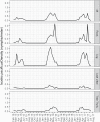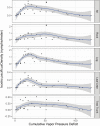A Comparison of Questing Substrates and Environmental Factors That Influence Nymphal Ixodes pacificus (Acari: Ixodidae) Abundance and Seasonality in the Sierra Nevada Foothills of California
- PMID: 33860326
- PMCID: PMC8529963
- DOI: 10.1093/jme/tjab037
A Comparison of Questing Substrates and Environmental Factors That Influence Nymphal Ixodes pacificus (Acari: Ixodidae) Abundance and Seasonality in the Sierra Nevada Foothills of California
Abstract
In California, the western blacklegged tick, Ixodes pacificus Cooley and Kohls, is the principal vector of the Borrelia burgdorferi sensu lato (sl) complex (Spirochaetales: Spirochaetaceae, Johnson et al.), which includes the causative agent of Lyme disease (B. burgdorferi sensu stricto). Ixodes pacificus nymphs were sampled from 2015 to 2017 at one Sierra Nevada foothill site to evaluate our efficiency in collecting this life stage, characterize nymphal seasonality, and identify environmental factors affecting their abundance and infection with B. burgdorferi sl. To assess sampling success, we compared the density and prevalence of I. pacificus nymphs flagged from four questing substrates (logs, rocks, tree trunks, leaf litter). Habitat characteristics (e.g., canopy cover, tree species) were recorded for each sample, and temperature and relative humidity were measured hourly at one location. Generalized linear mixed models were used to assess environmental factors associated with I. pacificus abundance and B. burgdorferi sl infection. In total, 2,033 substrates were sampled, resulting in the collection of 742 I. pacificus nymphs. Seasonal abundance of nymphs was bimodal with peak activity occurring from late March through April and a secondary peak in June. Substrate type, collection year, month, and canopy cover were all significant predictors of nymphal density and prevalence. Logs, rocks, and tree trunks had significantly greater nymphal densities and prevalences than leaf litter. Cumulative annual vapor pressure deficit was the only significant climatic predictor of overall nymphal I. pacificus density and prevalence. No associations were observed between the presence of B. burgdorferi sl in nymphs and environmental variables.
Keywords: Borrelia; Sierra Nevada; environment; nymph; tick.
© The Author(s) 2021. Published by Oxford University Press on behalf of Entomological Society of America.
Figures



References
-
- Belozerov, V. N. 2009. Diapause and quiescence as two main kinds of dormancy and their significance in the life cycles of mites and ticks (Chelicerata: Arachnida: Acari). Part 2. Parasitiformes. Acarina 17: 3–32.
-
- Berger, K. A., Ginsberg H. S., Gonzalez L., and Mather T. N.. 2014. Relative humidity and activity patterns of Ixodes scapularis (Acari: Ixodidae). J. Med. Entomol. 51: 769–776. - PubMed
-
- (CDPH) California Department of Public Health . 2015. Vector-borne disease section annual report 2015. CDPH, Sacramento, CA.
-
- (CDPH) California Department of Public Health . 2017. Vector-borne disease section annual report 2017. CDPH, Sacramento, CA.
-
- (CDPH) California Department of Public Health . 2018. Vector-borne disease section annual report 2018. CDPH, Sacramento, CA.
MeSH terms
LinkOut - more resources
Full Text Sources
Other Literature Sources
Miscellaneous

